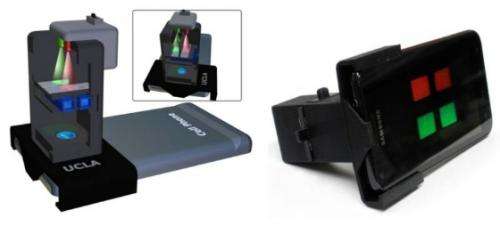Research team develops rapid smartphone-based mercury testing and mapping

(Phys.org) —A team of researchers from the UCLA Henry Samueli School of Engineering and Applied Science has developed a smartphone attachment and application to test water for the presence of mercury, a toxic heavy metal. The new platform could significantly reduce the time and cost of the testing, and it could be particularly useful in regions with limited technological resources.
Traditionally, water has been tested for mercury contamination in laboratories using large, expensive instruments, and the procedure requires complex preparation by professionally trained personnel. The new technology uses an inexpensive and lightweight attachment that was produced at UCLA using a 3-D printer, and the test can be performed easily by anyone after only minimal training.
"Our new platform for mercury testing is essentially a lab on a phone," said Aydogan Ozcan, the Chancellor's Professor of Electrical Engineering and Bioengineering at UCLA, associate director of the UCLA California NanoSystems Institute and the principal investigator on the research. "It's portable, lightweight and inexpensive to manufacture. And, because of the global proliferation of mobile devices, it could make testing for mercury widely available. Having this kind of test available in resource-limited areas and in the field was an important motivation for our work."
The research has been published online in the peer-reviewed journal ACS Nano.
To perform the test, a user collects a water sample in a disposable test tube and then holds it up to a smartphone equipped with the optical attachment. Using the attachment's light-emitting diodes, which are set to two specific frequencies, the device detects subtle changes in how light is transmitted to the phone's built-in camera due to mercury-induced nanoparticle clustering in the water.
The test, which uses nanoscale gold particles and short fragments of synthetic DNA that are extremely sensitive to the presence of mercury ions, can detect mercury concentrations of 3 to 4 parts per billion (ppb), which is about the maximum safe concentration level for drinking water according to standards set by the U.S. Environmental Protection Agency (2 ppb), and the World Health Organization (6 ppb).
The entire process can take as little as 20 minutes per test, including 10 minutes of incubation time.
The platform also includes an Android app that processes the images and quantifies the test results, then organizes the results from tested sites into an online map. This could help track mercury pollution in the environment.
The researchers estimate that the cost per test could be as low as five cents. The attachments, which weigh less than 40 grams, cost about $37 each to produce using a 3-D printer, and could be manufactured at a lower cost if they are made in large quantities.
More information: "Detection and Spatial Mapping of Mercury Contamination in Water Samples Using a Smart-Phone." Qingshan Wei, Richie Nagi, Kayvon Sadeghi, Steve Feng, Eddie Yan, So Jung Ki, Romain Caire, Derek Tseng, and Aydogan Ozcan. ACS Nano Article ASAP DOI: 10.1021/nn406571t
Journal information: ACS Nano
Provided by University of California, Los Angeles




















